There’s a Dead Guy in the Arch!
The Oldest Public Park in the US, Bushnell Park, Hartford
Multiple Visits
There is much debate over what constitutes a “public park” and which was the first in the US. I am no authority on either, but the claim has been made, dubious as it may be, so this page exists.
For several years here, I never thought to include a page about Bushnell Park. Then I started learning more about it when I was researching/writing stuff for some of the attractions in and near the park and said to myself, “Steve, this is worth a page. Sure you didn’t really take any pictures for this write-up and sure it’s just a giant lawn in the middle of Hartford, but do it anyway. Do it for the people.”
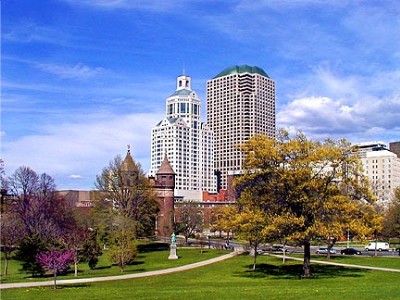
So here you have it. And even if you have walked through at least a portion of the park a million times before, I think you’ll find this pretty cool. “This” being the conception and history of Bushnell Park. Heck, there’s a dead guy in the giant Memorial Arch!
From the excellent Bushnell Park Foundation website:
Hartford in the 1850s was a rapidly growing river town, doubling in population from 1850 to 1860. The city’s economy was booming, driven by industries such as publishing, insurance, banking, munitions, manufacturing and river shipping. Like many American cities of the time, Hartford was enjoying the benefits of the Industrial Revolution. But along with this growth came some growing pains, including crime, crowded tenements, poverty, poor sanitation, polluted water and air. These problems were a growing concern of civic leaders at mid-century.
Andrew Jackson Downing (1815-1852) was the primary influence in the creation of a national park system in the United States. By 1848, he was advocating the creation of urban parks financed by private funds for the enjoyment of select groups of people. But he never advocated publicly financed parks. In 1851, a proposal was made to establish a centrally located park in New York City. And land for New York’s Central Park was privately purchased in 1853. Later that year, recognizing the need for open space in Hartford, CT, the Reverend Horace Bushnell presented an idea that had not been suggested in any other American city–the creation of a public park, financed by public funds.
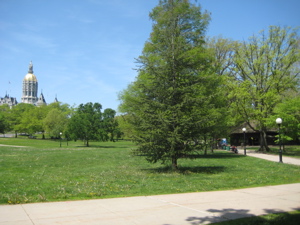
Initial public reaction was skeptical. Hard-nosed business leaders were opposed to removing taxable property from the tax rolls. Furthermore, it was hard to imagine a less likely place for a green, peaceful park than Bushnell’s proposed site, which was home to two leather tanneries, a soapworks, pigsties and other livestock–even a garbage dump. A railroad spur ran through it and the smelly Park River, polluted with the city’s industrial waste, ran alongside it. Crowded tenements lined both banks of the river, with their outhouses in the back emptying directly into the sluggish current. Even Rev. Bushnell described it as “hell without the fire.”
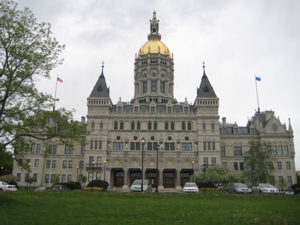
However, after hearing Dr. Bushnell’s presentation in October 1853, the Hartford City Council voted unanimously in November to spend public funds–$105,000-to buy the land that was to become Bushnell Park. Hartford voters approved the expenditure on Jan. 5, 1854, by a vote of 1,687 to 683, making it the first municipal park in the nation to be conceived, built and paid for by citizens through a popular vote.
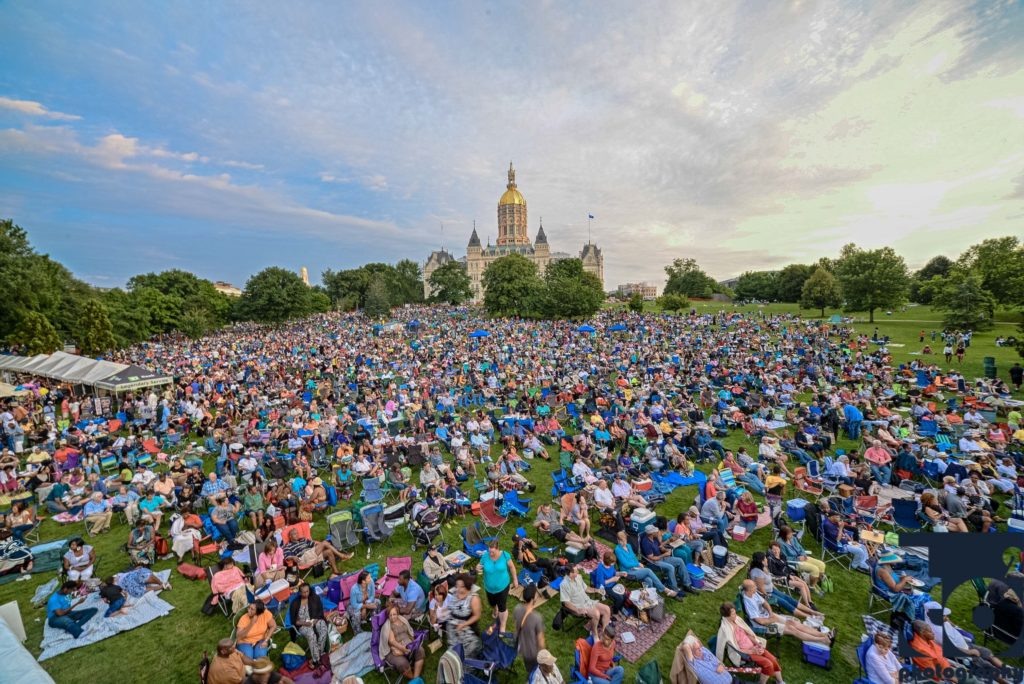
Jazz Fest!
But six years later, the park still had not taken shape. It was clear that a new and comprehensive park plan was needed. Bushnell asked his life-long friend, Frederick Law Olmsted, a Hartford native and world-famous designer of New York’s Central Park, to design the park. However, Olmsted could not grant Bushnell’s request since he was busily designing Central Park at the time. He recommended that the city hire Jacob Weidenmann, a Swiss-born landscape architect and botanist to design and build the park.
Weidenmann’s plan of 1861 had a distinctive natural style, which featured smoothly sculpted contours and graceful paths leading to focal points like the meandering Park River. The plan included informal clusters of evergreen and deciduous trees, which screened the sites and sounds of the city, a departure from the formal New England square or central green.
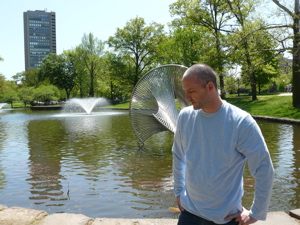
As part of the plan, Weidenmann selected 157 varieties of Trees and shrubs from North America, Europe and eastern Asia to grace the park. A total of 1,100 individual specimens were planted, creating a canopy of green covering the Park. Over the years, many important architectural features, such as the Soldiers & Sailors Memorial Arch (1886), the Capitol (1876), Corning Fountain (1899), the Carousel (1974) and the Performance Pavilion (1995) were added, while other scenic elements, such as the Park River and its several graceful bridges, were demolished in the 1940s. A major transformation in the park occurred at this time when the firm of Olmsted and Olmsted of Brookline, Mass., (Frederick Law Olmsted’s son’s firm), was retained to assist the city in redesigning the Park after the burial of the Park River was completed. Although changed, Bushnell Park today remains an oasis in the heart of the city where people from all walks of life come to renew their spirit and energy.
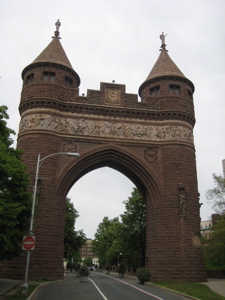
There’s really not too much I can add to that, but somehow I’ll find a way. One of my goals is to canoe the buried Park River mentioned just above. Though officially illegal (for now), it would be a coup-de-grace for me. Great New York Times article about it here.
Park designer Jacob Weidenmann also designed the beautiful Cedar Hill Cemetery in Hartford’s South End. One Mr. George Keller designed the impressive arch to that same cemetery as well as the huge Soldiers & Sailors Memorial Arch Memorial Arch in the park. And check this out:
[Keller] was a very proud man, who, despite spending his early career working in cemeteries, and designing elaborate grave markers, “had a horror of cemeteries,” as one of his children wrote. As a result, he asked to be buried in one of his favorite monuments, the Soldiers and Sailors Memorial Arch. So, when he died at age 93, he was cremated and his ashes were placed behind a plaque in interior wall of the east tower. Mary, apparently thought this was such a good idea that she decided to follow his example. So, when she died in 1946, her ashes were placed beside those of her husband in the Arch.
I visited the arch and climbed up inside it… certainly one of the cooler things to do in the park. There are notable trees here and several statues of important Connecticut people like Israel Putnam and Horace Wells. Bushnell Park is nothing more than a cut-through for many. But if you take a moment to slow down and notice a few things, from the ornate and beautiful Capitol Building to the flyer for the next Jazz Concert, you’ll be better for it.

![]()
Bushnell Park Foundation
CTMQ’s Firsts, Onlies, Oldests, Largests, Longests, Mosts, Smallests, & Bests
CTMQ’s Bushnell Park Carousel visit

 dick hemenway says
dick hemenway says
June 5, 2008 at 4:58 amSteve
Great report as usual, but your readers might be interested in the Park River’s more colorful (or smelly) past as The Hog River – an appropriate name at the time http://www.hogriver.org/issues/v01n01/hog_river_history.htm
For great background stories like this I suggest that you subscribe to the Hog River Journal, a Hartford Public Library publication http://www.hogriver.org/subscription_form.htm
 ROBERT BUSHNELL says
ROBERT BUSHNELL says
January 25, 2010 at 12:20 pmWHEN IS THE NEXT FAMILY REUNION?
 Steve says
Steve says
January 25, 2010 at 8:31 pmWhat in the world gave you the impression that this blog has anything in the world to do with your family reunion?
 Andrew Noone says
Andrew Noone says
February 11, 2013 at 12:35 pmIn fact, Worcester’s Elm Park beat Bushnell to the punch…Elm Park is the nation’s oldest park (if you discount commons), which was up and running in 1854.
 Katie says
Katie says
March 5, 2013 at 2:37 pmNo Way, Jose
The SECOND oldest public park in America was established in 1709 in San Antonio, Texas by King Phillip V of Spain. I was trying to determine where first oldest park was located, and came upon this report. Unless this park predates 1709, you are probably not right about calling this park the first. There is one in Boston dating to the mid-1600s which I will go back and verify.
So much for the internet and blogs. Doesn’t anyone check the facts anymore?
 Steve says
Steve says
March 5, 2013 at 3:29 pmWho wants to be the one to tell Katie that Texas wasn’t a state until 1845 and therefore the claim of anything “in the nation” prior to 1845 is utter nonsense?
Or that King Phillip V didn’t actually declare San Pedro Park a park until 1729 anyway?
Regardless, as with all these “oldest in the nation” things, there are caveats and footnotes and specificialities galore. I know that. But in this case I think Bushnell Park has a solid base to its claim. Even over Elm Park up in Worcester.
Bushnell is the first municipal park in the nation to be conceived, built and paid for by citizens through a popular vote. Elm Park was just some land set aside by the city to be a park and wasn’t developed until many years later. As for this Texas claim, well, there is no comparison.
The idea that a popular vote was taken and the citizens agreen to pay for the park themselves, the city needing to buy the land and all that – that was pretty darn revolutionary in 1854.
 Brent says
Brent says
July 10, 2013 at 1:56 pmHere is a list of the oldest city parks as defined by the Trust for Public Land…
http://cityparksurvey.tpl.org/reports/report_display.asp?rid=26
Regardless of how these parks were conceived, or paid for, etc., this is a list of pure age of parks located in current day America.
 Adriana says
Adriana says
October 29, 2013 at 12:30 pmwhat is the first public in America
 Chris Kelly says
Chris Kelly says
June 26, 2014 at 8:59 amI found your blog trying to track down what is the oldest public park. I give tours of the Arch and always say it’s the Bushnell, but now I’m seeing elsewhere Boston Common listed. I wonder if it has to do with where the funding originated, or some other technicality.
BTW: yours is a fantastic article of the park. I read much to get to where you got.
 Marcos says
Marcos says
November 9, 2014 at 7:08 amSteve, the question is very simple and basic. Oldest park in America, period. Does not matter who or what controlled the place.